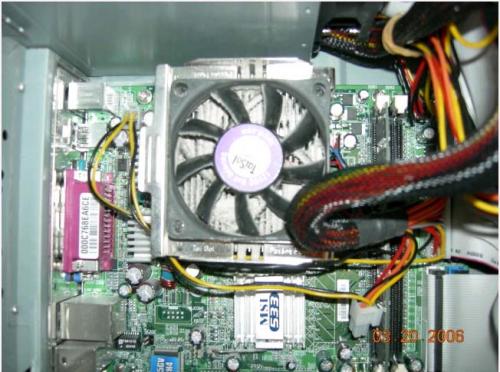01-Titan8990 [CPU Running Hot] 4th MAR-2007
Cooling Design Comments
2) PSU's fan is on the bottom of the power supply inches from my processor (but I think that fan sucks air in and blows it out the back).
The
Power Supply should be located in top rear corner The Intake fan is generally on the bottom of the Unit and should be
drawing air in and the
rear power supply fan should be
Exhausting hot air out the rear of the case -
I am running an 550w Antec Trio PSU
This is a fair size Power Supply Is it the PSU that came originally installed? Sounds as if you need a larger case size You can have
too many fans That
Air Turbulence can cause
Overheating by
Ineffective Cooling Design
The case has too be large enough to allow for
ample/sufficient air supply
"Bad/heatsink fan" -
Inspect fan for Worn Bearings or Broken Fan Blades How old is the CPU Heat sink & Fan Assembly Is it full of Dust so that the heat sink is clogged & Air is trapped inside?
Do you
also have a side fan blowing air in the same area that the CPU Fan & the Power Supply Intake Fan are operating This could be causing
extreme
Turbulence so that the CPU Fan is actually
starving for air
"I'm thinking about buying a new heatsink and using the gel thermal compound but I'm a little afraid to because i have ruined a mobo and a cpu with it before."The purpose of the
thermal gel/paste is to
smooth out the imperfections of the metal heat sink and to
evenly transfer the heat from the CPU (
heat source) to the heat sink assembly by eliminating all the tiny
hot spots caused by the imperfection high/low spots
"Any suggestions for real nice heatsink brand?" Brand is not the problem as much as the application -
Too much of the paste will act as an
insulator and degrade the heat transfer and cause early CPU Failure-
The
correct application of this thermal paste is
essential If the application is too difficult there are
heat transfer pads that are not as effective as a good paste application but is better than a poor application or none at all -
Also there usually is a
protective covering that must be removed If this is not removed then heat transfer is pretty much eliminated -
It is an Intel p4 2.8 and has the fan that came with it mounted on.Who mounted/installed the CPU & Fan Assembly? The Fan should be rotating so that the air is being forced down onto the CPU and being forced out the side fins of the heat sink assembly Now there needs to be a Larger Exhaust Fan in the rear of the Case To exhaust the hot CPU quickly out of the Case
Smaller fans can be added in the front of the case ahead of the Drive Assemblies - to draw air in and across the Drives for their cooling These should be smaller & should be running slower You need ample cool air supply not a fast moving turbulent supply The exhaust fans should be running faster and should be using a speed control This will make the cooling more efficient & less turbulent (also will keep noise/interferance down)
Antec back fan,
I have a 120mm fan in the back blowing out and a 80mm on the top and side blowing in.
The rear fan is in addition to the internal Power Supply? That is good if it is The other 80 mm fan may not be such a good idea Depending on where it is actually located at, perhaps it could be another exhaust fan??
Side fans usually do not help as much as just having some air louvers/vents for added air supply The smaller intake fans should be installed in the front lower area and the larger exhaust fans should be installed in the upper rear area -
The Video Card may have a fan also This fan needs to have some breathing area also Usually it is a good idea if the 1st expansion PCI slot is held open to allow for air supply for Video Card This is generally the spot for the additional side fan, which would aide in Turbulence around the Video Card??
In essence
More Cooling is not better It is
Efficient/Effective Cooling that is required -
Antec uses fan speed control on its power supply cooling fans & also supplies up to 3 additional Case Fan Power Plugs to be used for
fans only &
not for other peripherals This is because these fans are connected across (+12 Volt & +5Volt) for an effective variable (0 to +7 Volt) instead of a constant 5Volt.
I think 3 is too many intake fans If you have several hard drives in front you may need maybe 2 fans to help extend the life of these drives They should be small and running slow just to evacuate the hot air from lingering on the drives is all that is necessary because the back of these drives sits the Motherboard Keeping the cables properly/orderly maintained would help in more efficient cooling
This is a side effect of the SATA drives smaller & more manageable cabling keeps the hot spots/pockets from occurring
Additional reading material -
Antec heat transfer
http://www.antec.com...IYArticle2.htmlAntec cooling article
http://www.antec.com...IYArticle3.htmlArticles
http://www.antec.com/us/info_DIY.htmlCooling components
http://www.antec.com...ro_cooling.htmlJack123
Edited by Jack123, 04 March 2007 - 09:02 PM.


















 Sign In
Sign In Create Account
Create Account

